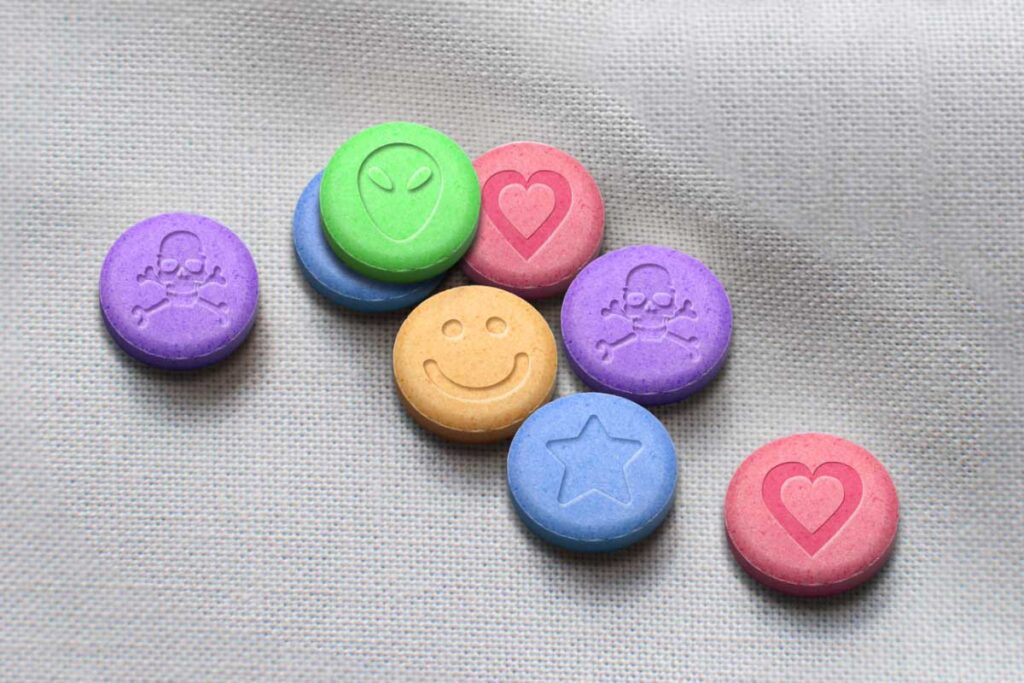
Ecstasy, also known by its chemical name MDMA (3,4-methylenedioxymethamphetamine), is a popular party drug that has gained widespread use due to its stimulant and hallucinogenic effects. Known for producing feelings of euphoria, emotional warmth, and enhanced sensory perception, MDMA is often used recreationally in social settings like raves, clubs, and music festivals. But despite its seemingly “fun” reputation, Ecstasy is far from harmless. It can be addictive, dangerous in high doses, and potentially life-altering with long-term use.
If you or someone you love has been using MDMA and is wondering how long Ecstasy stays in your system, the answer depends on several factors, including frequency of use, dosage, metabolism, and the type of drug test being administered.
At 10 Acre Ranch, a pet-friendly drug and alcohol detox and treatment center in Southern California, we’re committed to providing comprehensive care for individuals struggling with MDMA or other substance use disorders. Let’s explore the timeline of MDMA in the body, how it’s detected, and why professional treatment may be needed for recovery.
What Is Ecstasy (MDMA)?
MDMA is a synthetic psychoactive substance with both stimulant and hallucinogenic properties. While some users take “pure MDMA,” commonly referred to as Molly, street versions of Ecstasy are often cut with other substances like methamphetamine, caffeine, bath salts, or opioids, making their effects unpredictable and potentially dangerous.
When taken, MDMA increases the activity of three neurotransmitters:
- Serotonin: Responsible for mood, appetite, and sleep
- Dopamine: Associated with reward, pleasure, and motivation
- Norepinephrine: Affects energy and alertness
This surge of neurotransmitters leads to the intense feelings of euphoria and connection many users report. However, the “crash” that follows can result in depression, fatigue, anxiety, and irritability that may last for days.
How Is Ecstasy Used?
MDMA is usually taken in pill or capsule form, though it can also be snorted or dissolved in water. A typical recreational dose ranges between 75 mg to 125 mg, but because pills are unregulated and often contain other drugs, dosage is often uncertain.
Effects usually begin within 30 to 45 minutes and peak at about 1.5 to 2 hours after ingestion. The overall experience can last 3 to 6 hours, though aftereffects can linger much longer.
How Long Does Ecstasy Stay in the Body?
While the effects of MDMA wear off within a few hours, traces of the drug can remain in your body for days or even weeks, depending on the type of drug test used. Below is a breakdown of how long Ecstasy can be detected in various parts of the body:
1. Blood
- Detection time: Up to 1–2 days
- How it works: Blood tests are typically used in emergency settings or legal investigations. MDMA is rapidly absorbed into the bloodstream, but it also clears relatively quickly.

2. Urine
- Detection time: Typically 1 to 3 days, but may last up to 5 days in heavy users
- How it works: Urine testing is the most common method for detecting MDMA. In frequent users, detection windows can be longer due to drug accumulation in the body.
3. Saliva
- Detection time: Around 24 to 48 hours
- How it works: Saliva tests are less invasive and offer a short detection window, typically used for roadside testing or employment screenings.
4. Hair
- Detection time: Up to 90 days
- How it works: Like many drugs, MDMA can be detected in hair follicles long after use. Hair testing is uncommon but useful in identifying long-term or habitual drug use.
Need Help? Let’s Talk!
Your path to recovery begins with a simple conversation.
Call now to speak confidentially with an admission counselor.

Factors That Affect Detection Times
Several variables influence how long Ecstasy stays in your system:
- Frequency and amount of use: The more often you use, the longer it takes to metabolize.
- Purity of the drug: Street Ecstasy is often laced with other substances that may linger longer in your system.
- Metabolism: A faster metabolism helps eliminate substances quicker.
- Age, weight, and overall health: Liver and kidney function play a role in processing and expelling drugs.
- Hydration and activity level: These can impact how quickly the drug is flushed from your system.
Signs of MDMA Use and Abuse
Recognizing signs of MDMA use can help identify a potential problem before it escalates. Some common short-term signs include:
- Elevated mood or euphoria
- Increased sociability and talkativeness
- Teeth grinding or jaw clenching
- Dilated pupils
- High energy and restlessness
- Unusual sweating or overheating
Long-term or frequent use may result in:
- Memory problems or cognitive impairment
- Mood swings, anxiety, or depression
- Sleep disturbances
- Impaired judgment and risky behavior
- Tolerance and the need to take higher doses
- Emotional withdrawal or isolation
These symptoms may indicate that someone is developing a psychological or physical dependence on MDMA, even if they only use it during “fun” occasions.
Is MDMA Addictive?
While MDMA is not considered physically addictive in the same way as heroin or alcohol, it can be habit-forming and psychologically addictive. Some users develop cravings and dependency, particularly for the social and emotional high it offers. As tolerance builds, people may take more of the drug to feel the same effects, increasing the risk of overdose or long-term brain changes.
Withdrawal from MDMA isn’t typically life-threatening, but it can be emotionally and mentally challenging. Symptoms may include:
- Fatigue and low energy
- Anxiety or panic attacks
- Depression and irritability
- Difficulty concentrating
- Insomnia or hypersomnia
These symptoms often make it difficult to stop using without professional help.
Can Detox Help with Ecstasy Use?
Yes. Although physical withdrawal symptoms from MDMA are usually less severe than from other substances, the psychological withdrawal can be intense, especially for those who’ve used the drug frequently.
At 10 Acre Ranch, our medically supervised detox program offers a safe and supportive environment where clients can begin the process of recovery. Detox helps the body eliminate MDMA while providing emotional support and medical care to manage symptoms.
We offer:
- 24/7 medical monitoring
- Nutritional support and hydration therapy
- Counseling to help manage mood disturbances
- Introduction to long-term recovery planning
Detox is the first step toward a drug-free future, and it sets the foundation for sustainable healing.
Ongoing Treatment After Detox
Successfully completing detox from MDMA is an important milestone—but true recovery requires ongoing support. At 10 Acre Ranch, we offer:
1. Residential Treatment
Live in a structured, supportive environment focused on therapy, relapse prevention, and personal growth. Our pet-friendly facility in Southern California allows you to bring your dog or cat, helping to reduce stress and offer companionship as you heal.
2. Outpatient Programs
Perfect for those who’ve completed detox and are ready for more independence, outpatient treatment offers flexibility while maintaining accountability and therapeutic support.

3. Individual and Group Therapy
Our counselors help you explore the underlying causes of substance use, such as trauma, mental health issues, or life stressors.
4. Dual Diagnosis Care
Many people struggling with MDMA addiction also suffer from depression, anxiety, or PTSD. Our dual diagnosis program treats both addiction and mental health simultaneously.
Staying Clean After Ecstasy Use
Relapse prevention is a key component of recovery. MDMA may not produce strong physical cravings like opioids or alcohol, but emotional triggers—like loneliness, peer pressure, or stressful life events—can lead to reuse.
Here are some tips to maintain sobriety:
- Build a sober support network
Attend 12-step or non-12-step recovery groups, connect with sober friends, and build accountability. - Develop healthy coping strategies
Exercise, journaling, art, meditation, or therapy can help you manage your emotions without turning to drugs. - Avoid high-risk environments
If clubs, parties, or festivals were places you used MDMA, consider skipping them during early recovery. - Set goals and find purpose
Volunteering, career development, and hobbies can help replace the void left by substance use.
Final Thoughts
So, how long does Ecstasy stay in your system? The answer varies depending on several individual factors, but on average, it can be detected in urine for 1–3 days, in blood for up to 2 days, and in hair for up to 90 days. However, the more important question is—how is it affecting your life?
Whether you’re feeling stuck in a pattern of party drug use or struggling to stop taking MDMA on your own, 10 Acre Ranch is here to help. Our evidence-based programs provide detox, therapy, and long-term support in a compassionate, home-like setting.
And yes—you can bring your pet, too.
If you’re ready to stop wondering how long Ecstasy stays in your system and start your journey toward healing, reach out to 10 Acre Ranch today. We’re here to walk with you—every step of the way.
Contact 10 Acre Ranch to learn more about our detox and residential treatment options. Your future is worth it.






